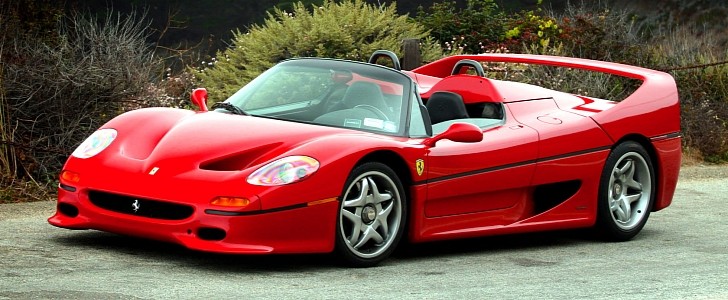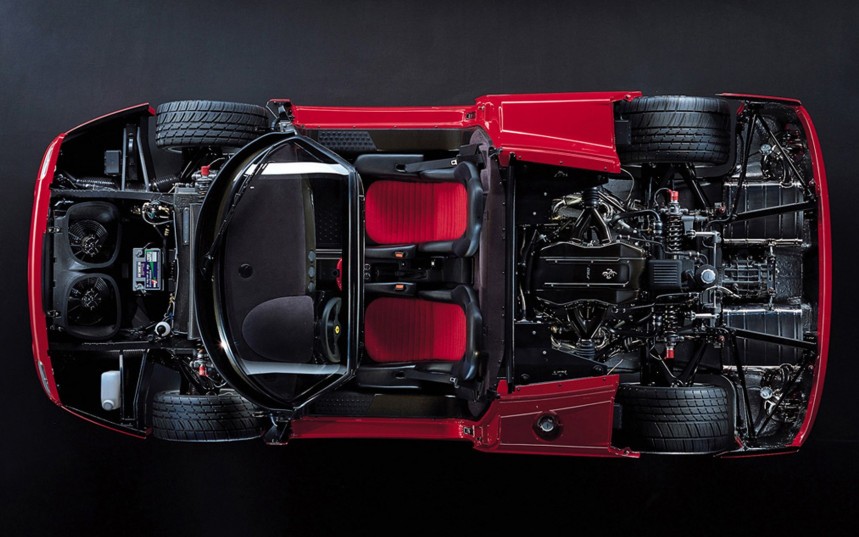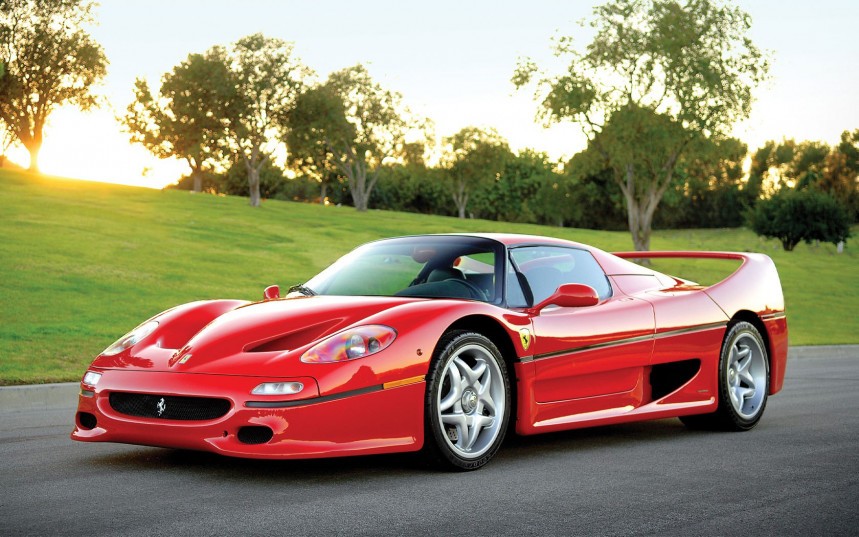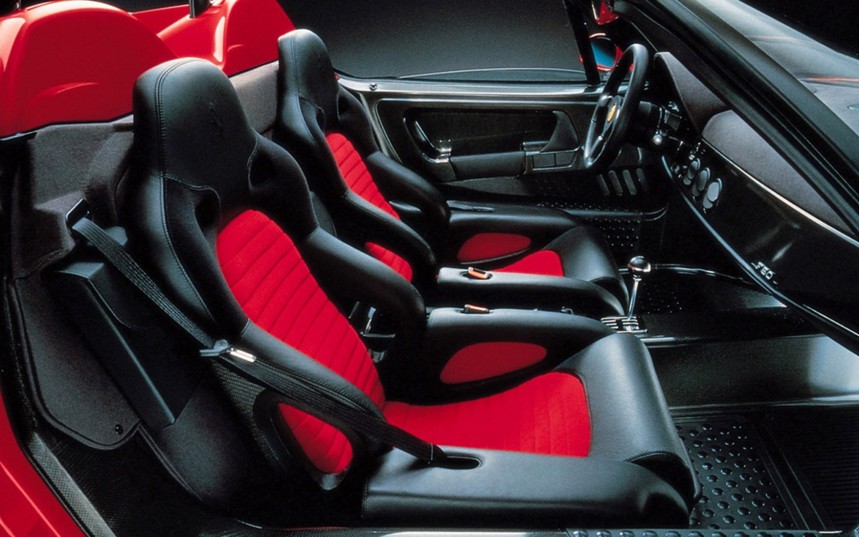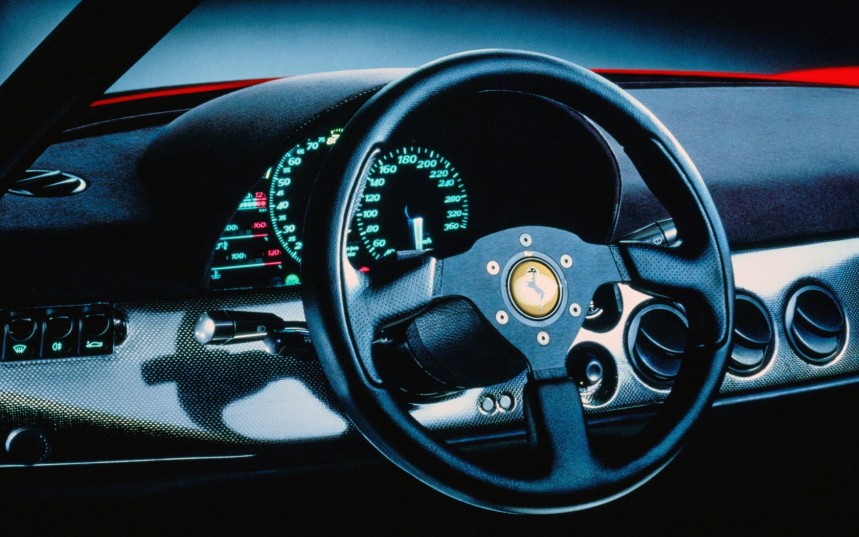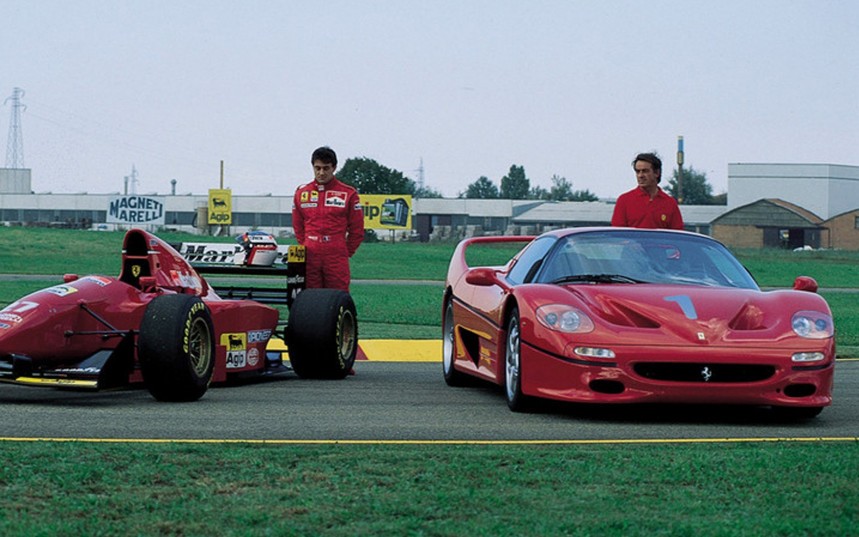After the tremendous success of the F40, the legendary carmaker was determined to exceed expectations again, delivering an extreme road-legal machine that brought proven Formula One technology to the streets.
Its predecessor was one of the most successful models Ferrari had ever built. They had planned just 400 units, but the demand was so high that 1,315 F40s ended up being built in five years.
To satisfy the thirst for road-legal racecars that were taken to another level by the F40, Lamborghini Diablo or McLaren F1, the Maranello manufacturer started to develop a completely new car that was as close to a Formula One racer as possible.
Unlike its predecessor that had to be completed in eleven months, engineers had more time to develop the new machine. It would be built to celebrate fifty years of mass-produced Ferraris, but it was ready two years earlier.
While the 288 GTO and F40 were built on a nearly identical tubular steel chassis, the F50 utilized a completely new construction. For the first time on a roadworthy vehicle, Ferrari used a cutting-edge carbon fiber monocoque chassis inspired by its F1 racecars. It was designed by Cytec Aerospace and used a Nomex honeycomb core structure, which to this day is one of the most advanced lightweight non-metallic composite construction.
The fully-independent suspension system also borrowed elements from F1 cars. It featured rose-jointed unequal-length wishbones and a pushrod system, along with horizontally mounted springs and Bilstein gas-pressurized monotube shocks with adaptive damping control and electronic height adjustment.
The body was designed by long-time partners Pininfarina, but unlike many previous Ferrari models, Leonardo Fioravanti was not involved since he had left the company a few years earlier.
Lorenzo Ramaciotti and Pietro Camardella were responsible for the design, which was inspired by the Mythos concept while combining several small features from the F40 like the big front and rear sections. The result was not Ferrari’s best-looking car, as the design team focused more on aerodynamics and weight saving than aesthetics. A removable roof was fitted, but it could not be stored inside, which didn’t make it very convenient.
The new supercar's cockpit kept the raw, minimalistic design of its predecessor. Air conditioning was the only piece of contemporary technology, with everything else conceived with weight reduction in mind.
The F50 did not use a twin-turbocharged V8 like its ancestors but instead was fitted with an enlarged version of the V12 used in the 1990 Ferrari 641 Formula One car driven to a Constructor’s Championship by Alain Prost and Nigel Mansell.
The mid-mounted 4.7-liter (4,698.50 cc; 286.7 cu in) naturally aspirated unit featured a modular cast-iron block, forged Mahle pistons with forged titanium rods, a polymer-reinforced carbon fiber intake manifold, and a Bosch Motronic 2.7 sequential injection system. It achieved a maximum output of 519 PS (382 kW; 512 hp) while the peak torque of 471 Nm (347 lb-ft) was transmitted to the rear wheels via a six-speed manual gearbox and a limited-slip differential.
This enabled the F50 to accelerate from a standstill to 100 kph (62 mph) in 3.87 seconds, reaching a top speed of 325 kph (202 mph). Stopping power was provided by an advanced braking system derived from F1 and designed by Brembo. It used four-piston aluminum calipers, cross-drilled cast iron rotors, and Pagid brake pads.
The F50 was launched in 1995 at the Geneva Motor Show and was met by mixed reactions. The public criticized the bodywork, which many found unappealing, and the decision to bolt the engine directly to the chassis, which made for a spine-damaging experience, even with the adaptive suspension.
It never lived up to the success of the F40, and Ferrari denied journalists' requests to test the two cars side-by-side as rumors that it was slower than its predecessor quickly spread.
Only 349 units were produced from 1995 to 1997 and, unlike past models, the F50 was available in five distinct colors. Only 47 F50 came out of the factory gates in a different color than the legendary Rosso Corsa, though.
Four years ago, the F50 was featured in Top Gear’s Nürburgring Nordschleife challenge, completing a lap in 7 minutes and 45 seconds. It was faster than the Dodge Challenger SRT Hellcat but 28 seconds slower than the Mercedes-AMG GT R.
It may not be as popular as the F40 or other supercars of the era, but the F50 is one of the most revolutionary models ever built in Maranello, pioneering technology transfer from Formula One to the road and paving the way for all modern Ferrari cars.
To satisfy the thirst for road-legal racecars that were taken to another level by the F40, Lamborghini Diablo or McLaren F1, the Maranello manufacturer started to develop a completely new car that was as close to a Formula One racer as possible.
Unlike its predecessor that had to be completed in eleven months, engineers had more time to develop the new machine. It would be built to celebrate fifty years of mass-produced Ferraris, but it was ready two years earlier.
The fully-independent suspension system also borrowed elements from F1 cars. It featured rose-jointed unequal-length wishbones and a pushrod system, along with horizontally mounted springs and Bilstein gas-pressurized monotube shocks with adaptive damping control and electronic height adjustment.
The body was designed by long-time partners Pininfarina, but unlike many previous Ferrari models, Leonardo Fioravanti was not involved since he had left the company a few years earlier.
The new supercar's cockpit kept the raw, minimalistic design of its predecessor. Air conditioning was the only piece of contemporary technology, with everything else conceived with weight reduction in mind.
The mid-mounted 4.7-liter (4,698.50 cc; 286.7 cu in) naturally aspirated unit featured a modular cast-iron block, forged Mahle pistons with forged titanium rods, a polymer-reinforced carbon fiber intake manifold, and a Bosch Motronic 2.7 sequential injection system. It achieved a maximum output of 519 PS (382 kW; 512 hp) while the peak torque of 471 Nm (347 lb-ft) was transmitted to the rear wheels via a six-speed manual gearbox and a limited-slip differential.
The F50 was launched in 1995 at the Geneva Motor Show and was met by mixed reactions. The public criticized the bodywork, which many found unappealing, and the decision to bolt the engine directly to the chassis, which made for a spine-damaging experience, even with the adaptive suspension.
Only 349 units were produced from 1995 to 1997 and, unlike past models, the F50 was available in five distinct colors. Only 47 F50 came out of the factory gates in a different color than the legendary Rosso Corsa, though.
Four years ago, the F50 was featured in Top Gear’s Nürburgring Nordschleife challenge, completing a lap in 7 minutes and 45 seconds. It was faster than the Dodge Challenger SRT Hellcat but 28 seconds slower than the Mercedes-AMG GT R.
It may not be as popular as the F40 or other supercars of the era, but the F50 is one of the most revolutionary models ever built in Maranello, pioneering technology transfer from Formula One to the road and paving the way for all modern Ferrari cars.
